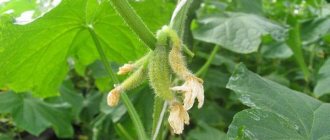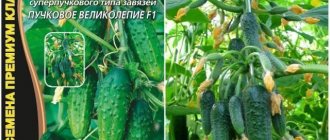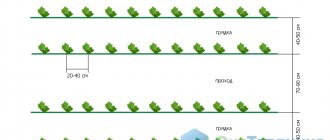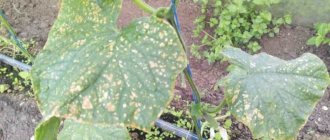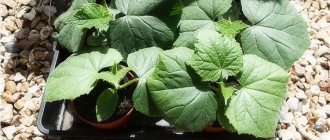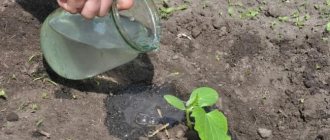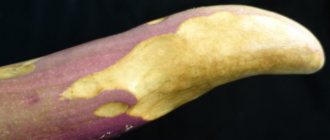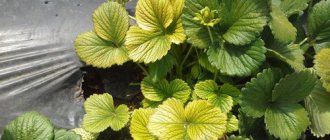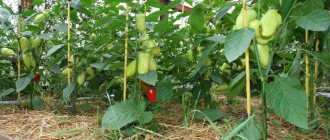Poor quality seeds
If you choose low-quality cucumber seeds for sowing in open ground (or a greenhouse), or for seedlings, you may encounter this unpleasant problem. What does low-quality seeds mean? This refers to seeds that the summer resident collected independently from his plants. After all, the seeds could have been obtained as a result of cross-pollination with hybrids, which means that they could grow into plants with unpredictable properties. In addition, young seeds (at the age of 1, 2 years) can be considered low-quality.
Solution to the problem:
- Buy cucumber seeds from reliable producers who have a good reputation and produce quality products.
- Choose more mature seeds for sowing, the ideal age is 3-4 years (at least 2).
- If you still want to sow young seeds, it is recommended to artificially age them (i.e., heat them) before planting. To do this, you need to keep them at a temperature of 25-28 degrees Celsius for 1.5-2 months.
Violation of the optimal temperature regime of air and soil
Cucumber ovaries turn yellow and dry out from too high or low temperatures in greenhouse air or soil, or from sudden temperature changes over a short period of time. Plants suffer greatly when it gets cold during the day and especially at night, since their ovaries grow at night. Under such conditions, the root system of cucumbers does not develop, or this process goes poorly and may even begin to die. In cold soil, healthy roots lose their ability to normally absorb nitrogen from the soil, and the ovaries lack the essential nutrient they need.
There is an ideal temperature that must be maintained in order for cucumbers to grow and develop normally. Before fruiting it is:
- 22-24 °C – in clear weather;
- 20-22 °C – in cloudy weather;
- 17-18 °C – at night.
When the cucumbers begin to bear fruit, the temperature needs to be increased slightly:
- 23-26 °C – in clear weather;
- 21-23 °C – in cloudy weather;
- 18-20 °C – at night.
For varieties pollinated by bees, all temperature indicators should be 1-3°C higher.
The maximum temperature that cucumber plants tolerate well is up to 36 °C, the minimum is 13-15 °C. Temperature conditions above and below these limits have a negative effect on vegetating cucumbers; they either overheat or become overcooled. All this has the most negative effect on the growth and development of the ovaries; they begin to turn yellow.
Sudden temperature changes most often occur in greenhouses. During the day, the air and soil in them become very hot due to the fact that excess heat cannot escape, and at night they cool sharply. No crop welcomes such temperature changes, but cucumbers are most sensitive to them.
Measures to combat overheating of plants include:
- ventilation of greenhouses in hot weather;
- whitening the walls and roofs of shelters with chalk;
- shading plants with white reed shields or mats;
- abundant watering in the evening;
- mulching the soil under cucumbers with hay, straw, fresh sawdust, black film or agrofibre of the same color.
To avoid a drop in temperature at night, low greenhouses are covered with another layer of film and dark-colored containers filled with water are placed in them. During the daytime, the liquid will heat up and accumulate heat, and at night, it will release it into the air space. In large greenhouses, if electricity is supplied to them, electric or infrared heaters are installed. Stoves that burn wood, sawdust and pellets, for example, such as Buleryan, are excellent for heating such structures.
How to prevent yellowing of ovaries
The first measure to prevent yellowing of cucumber ovaries is to level out temperature fluctuations in the greenhouse:
- On hot and warm days, I make sure to open all the windows and doors for greater ventilation.
- On a cold night, I bring hot stones into the greenhouse - heated under the rays of the sun or in a bathhouse. Stone surfaces give off heat over a long period of time - the greenhouse will not cool down so sharply.
- If severe cold snaps are expected, I additionally cover the greenhouse plantings with non-woven insulation.
But it is worth remembering that prolonged cold spells are also destructive for cucumbers. In this case, yellowing of the ovaries can be prevented by the following measures:
- Erect a temporary film greenhouse around the greenhouse - this measure will allow the heat to remain longer. But the method is only suitable for sunny days - from a lack of lighting on cloudy days, the ovaries can also begin to turn yellow.
- Add growth stimulants according to the instructions - “Zircon”, “Epin”. These compositions have two advantages: they increase the immunity of plants against unfavorable environmental conditions, and stimulate the formation and maturation of green plants. After treatment with growth stimulants, I usually apply organic fertilizer.
Such preventive measures work 50/50 in rainy and chilly summers - they help to get a small, but not a royal harvest.
Another problem that can be prevented is cross-pollination of varietal and hybrid cucumbers. The simplest measure is to separately plant parthenocarpic and pollinated varieties:
- The distance between parthenocarpics and varietal cucumbers is no more than 500 m. Of course, this is disproportionate to the area of the garden or summer cottage.
- If you grow cucumbers in a small garden, try to isolate bee-pollinated ones from hybrids: grow them in different greenhouses, or some in the open and others in protected ground.
Cross-pollination is a great danger for hybrid varieties. If pollen gets on parthenocarpic flowers, this leads to yellowing, loss of ovaries, or the development of twisted, misshapen greens. Such a harvest does not have a long shelf life - it is only suitable for salads and soups.
I plant cucumbers in a greenhouse, which is illuminated by the sun at least 8 hours a day. If you do not have the opportunity to provide greenhouse plantings with such lighting, do not forget to spray them with growth stimulants from time to time - “Epin”, “Zircon”, etc. This simple measure will preserve the ovaries and get a harvest.
By the way, the collection of greens also needs to be given due attention in preventive terms. I noticed that on the bush, among other things, the ovaries begin to turn yellow and dry out when the finished crop, and especially the overgrown one, is not harvested on time. The fact is that green plants “magnetize” nutrients to themselves - there simply aren’t enough of them for new ovaries.
To prevent the latter from dying off, I try to organize the cucumber harvest every 2-4 days. I pick greens that have reached the stage of technical ripeness. If a cucumber is left on the vine “for seeds,” then I remove all the flowers and ovaries that form from this shoot so that the nutrients go only to this fruit.
As you can see, there are many reasons for the yellowing and falling of cucumber ovaries: some of them are a consequence of improper care, some are a consequence of the influence of surmountable and irresistible external factors. Our task here is to correctly find the origins of the problem and alleviate the condition of the plant so that it ultimately produces a good harvest.
Weak root system
With a weak root system, the plant cannot fully provide itself with nutrition and moisture. In this regard, normal ovaries also cannot form, or they immediately begin to turn yellow.
Solution to the problem:
- Handle cucumber seedlings carefully, without damaging their roots when picking or transplanting.
- Observe the timing of sowing seeds for seedlings in order to plant the plants in open ground or a greenhouse at the right time. And thus, the root system will be quite strong and developed.
A large number of ovaries
Hybrid cucumbers can produce a lot of female fruit. A large number of fruits require a lot of nutrition, and if the ovaries of cucumbers dry out, it means that there are few nutrients in the soil. When the plant does not have enough nutrition for new fruits, it begins to shed newly formed embryos. To solve this problem, you need to either additionally feed the bushes or remove excess ovaries.
- How dangerous are lice: pediculosis in humans
- Treatment of knee sprains
- Enteritis in dogs parvovirus, coronavirus and bacterial - symptoms, diagnosis and treatment methods
Lack of light
Cucumbers are one of the most demanding crops in terms of daylight hours. You need to make sure that the cucumber plantings have enough light at the stage of installing the greenhouse.
Light deficiency can also be caused by other green plants grown in a greenhouse. Often, beginning gardeners plant as many crops as possible in a greenhouse, and some begin to outstrip others in growth, shading them and preventing normal sunlight.
Violation of agricultural technology, namely refusal to pinch the bush, does not allow it to form correctly and contributes to the growth of side shoots. And they also shade the bush itself and nearby plantings.
What to do:
- Correctly orient the greenhouse to the cardinal points. For regions with a temperate climate, located in the middle zone and northern regions, the orientation of the greenhouse from east to west is considered optimal. In the southern regions it is advisable to place it from north to south.
- Try to plant cucumbers in the greenhouse according to the following scheme: parthenocarpic hybrids - 1-2 plants per 1 sq.m., and bee-pollinated varieties - 2-3 plants per 1 sq.m. Give the plants more space and then they will have enough light.
- Pinch the top part of the shoots and make sure that its length does not exceed 20-25 cm. Long shoots take away a significant part of the plant’s vitality, and it begins to wither.
- In a timely manner, “blind” the axils of the leaves, in which tendrils, side shoots and flower buds are hidden. As the plant grows, these “freeloaders” need more and more nutrition. By removing them, you will protect the mother bush and allow it to develop without wasting energy on forcing additional shoots and flowers.
Diseases and pests
Rapid drying and yellowing of the ovaries provoke various diseases. First of all, these are bacterioses that affect weakened or densely planted shrubs. The optimal environment for their development is temperature fluctuations.
Wilting is often observed due to root rot. The plant seems healthy, but is drying out at the top. Rot disrupts the flow of nutrients to all parts of the bush.
Pests
In addition to agrotechnical ones, there are also biological reasons that provoke wilting of cucumber ovaries.
The most famous pests that attack young plants:
- spider mite;
- nematode;
- aphid;
- black flea beetle;
- ants;
- whitefly
Insect activity peaks in mid-summer. Aphids, for example, overwinter in the basal part of the leaves of the weed, and in the spring they actively spread throughout the area. It is impossible to notice a spider mite right away; its presence is indicated by the cobwebs entangled in the plant. The pest quickly attacks crops, sucking the juice out of them and preventing them from developing. As a result, the plant dries out and dies.
The black flea beetle is considered the most dangerous pest; it is capable of completely destroying a plot of cucumbers in a matter of days. The whitefly is no less dangerous: after its attack, the leaves and ovaries turn yellow and fruiting stops.
Preventive measures
You can prevent yellowing of plantings in the following ways:
- if you disinfect garden tools before work;
- fertilizing the soil with rotten humus before planting;
- if you change the top soil layer in the greenhouse annually;
- constantly mulching the soil, sprinkling it with sawdust and removing weeds;
- keeping the distance between plantings;
- regularly harvesting.
Plants grow weak and prone to yellowing if the seed obtained and planted is of insufficiently good quality. Seeds are carefully selected and must be warmed before planting. The fruits grow strong and do not turn yellow if the plant is treated with boric acid. It is taken into account that for greenhouses a solution of lower concentration is made. After preventive treatment, cucumbers are not harvested for consumption for 3 weeks, so it is better to treat the ovaries that have begun to form.
Cucumbers turn yellow for various reasons, which raises the question of whether it is possible to eat yellowed cucumbers and whether it is dangerous. The answer is no, there is nothing dangerous. Sometimes yellowness is caused by fungal diseases or pests such as aphids, but most often the reason lies in improper care. Plantings are watered incorrectly, planted in the shade, and greenhouses are ventilated less often than necessary. If yellow leaves, ovaries and small cucumbers appear in spring or early summer, you should think about changing the method of care and carrying out preventive treatment of the bushes.
Lack of minerals
Cucumber ovaries also turn yellow and fall off in cases where all the nutrients in the soil have been exhausted and no additional fertilizing has been applied. Plants react no less sensitively to excess or incorrect ratios of added additives.
Typically, parthenocarpic cucumber hybrids suffer most from changes in the balance of minerals and macroelements. They need abundant watering, which, in turn, leaches potassium and nitrogen from the soil. It is the lack of these substances that should be compensated first. Before planting cucumbers, you should add 30 kg of manure per 1 square meter. m with digging the soil to a depth of 25 cm. What to do:
- Reduce or stop feeding manure.
- For 10 liters of water add 1 tbsp. urea, 3 tbsp. wood ash, mix thoroughly and spray the stems with the resulting solution.
- Use the drugs Sortvorin, Brexil calcium, Master, Kristalon and Kemiru according to the instructions.
- Fertilize the soil with wood ash at the rate of 300 g per 1 sq.m.
Cucumber embryos turn yellow
Yellowing of cucumber embryos occurs not only among beginning gardeners, but also among people with extensive experience in growing vegetables. This phenomenon is common, however, in most cases, you can get rid of the problem quite easily and quickly.
Causes
The main reasons why cucumber embryos turn yellow include the following:
- improper care (lack of moisture, light, heat);
- lack of nutrients;
- difficulties with pollination: this problem especially often arises in greenhouses, since bees simply cannot find their way to the plants and pollinate them;
- use of hybrid varieties of cucumbers: if earlier gardeners themselves prepared seeds for seedlings, today there is a huge selection of seedlings that can be purchased in the store, and these are in most cases hybrid varieties. More cucumber embryos are formed on hybrids, but some of them immediately turn yellow. One plant is not able to provide nutrients to all available fruits;
- cucumbers planted too densely: due to improper planting, the plant does not have enough light, in addition, if the seedlings are planted too densely, their root system will suffer;
- early flowering and fruiting: for a plant to begin to bear fruit, it must enter the necessary growth phase. If this does not happen, but flowers and cucumber embryos have already appeared, then it is necessary to remove the ovaries;
- lack of pinching: the lower leaves of cucumbers are useless; they take a lot of nutrients from the cucumbers. To prevent this from happening, they must be cut off.
What to do?
In order for the plant to have as many embryos as possible, it is necessary:
- monitor the temperature and watering regime;
- Correctly maintain the distance between cucumbers. This information is always on the back of the seed package;
- remove the lower leaves of mature plants in a timely manner;
- harvest on time;
- feed the plants in a timely manner;
- use special solutions to attract bees (water and honey), or plant flowers such as petunias or sunflowers in close proximity to the cucumbers, which will help attract bees and improve the pollination process.
As a rule, cucumbers in the beds are fertilized twice: during the transplant process and after two weeks.
For the first feeding use the following mixture:
- 45 g superphosphate;
- 25 g ammonium nitrate;
- 15 g potassium chloride;
- 20 g potassium salt.
After two weeks, chicken manure or cow manure should be used for feeding at a ratio of 1 kg of organic matter per 8 liters of water.
If the appearance of the plant deteriorates every day, the leaves wither and change color, and the fruits do not develop, it is necessary to add additional nutrients. For these purposes, a suitable fertilizer consisting of a glass of ash diluted in 10 liters of water. The leaves should be sprayed with it weekly.
Improper watering - excess or lack of moisture
Cucumbers, as humid tropical plants, are very partial to moisture, but in order for them to grow and bear fruit, they need to be watered correctly. Before fruiting begins, watering should be moderate, and with its beginning - more abundant. The optimal frequency of watering is every 1-2 days, in hot weather - daily (or even 2 times a day - morning and evening). In general, you need to look at the condition of the soil - if it is dry, you definitely need to water the beds. If the ground is wet, you can skip the next watering. The main thing is to maintain a balance, since a lack and excess of liquid in the soil is equally unfavorable and can lead to yellowing of the ovaries.
Water for watering this crop in a greenhouse must be free of chlorine and warm (23-25°C); cold water is not allowed (such liquid causes temperature stress to the roots, which ultimately affects the condition of the entire plant, including the ovary).
The best time for such events is evening or early morning. There is no need to do this during the day: the water will quickly evaporate, this will only increase the air humidity, while the plants themselves will be able to receive moisture in a minimal amount.
Causes of yellowing and wilting of the ovary in a greenhouse
If the ovaries on your greenhouse cucumbers have turned yellow, withered, or even fallen off, this may indicate the following:
- Formation of too many ovaries.
- Incorrect water treatment schedule.
- Lack of certain nutritional components - macro- and microelements.
- Violation of crop rotation rules.
- Poor or unsuitable soil for cucumbers.
- Thickened planting.
- Sudden temperature changes.
- Prolonged cloudy cold weather.
- Lack of light.
- Damage by diseases and pests.
- Not pollination of varietal plants.
- Cross-pollination of hybrids/varieties.
- Incorrect harvesting.
It is important to correctly understand the cause in order to stop and eliminate the loss of ovaries.
yellowing of cucumber leaves in a greenhouse
Thickened plantings
Cucumbers need a lot of light for normal growth and fruiting. Despite the fact that the beds for growing them and the greenhouses are always located in a sunny place, the plants themselves can shade each other. This happens if the seeds or seedlings were planted too densely.
At the initial stage of development, a small area is enough for plants. But with the growth of the bushes and the increase in green mass, the fruits find themselves in dense shade, which provokes yellowing of the ovaries and their subsequent falling off. Bee-pollinated varieties and hybrids throw out barren flowers, delaying fruiting.
Correct placement of plants can correct the situation. When choosing planting schemes and calculating the number of cucumber bushes per 1 m2, it is worth considering:
- sizes of beds in greenhouses and on the ground;
- design of shelters and trellises;
- whether the cucumbers being grown belong to one or another variety or hybrid;
- the degree of climbing of the plant;
- method of forming a bush;
- timing and place of cultivation.
On average, 3 to 6 cucumbers are placed per 1 m2. A gardener can obtain basic recommendations regarding the selected variety or hybrid from the manufacturer’s instructions on the seed packet. They must be adhered to in order to prevent thickening of the plantings and yellowing of the fruits.
Insufficient air humidity on cucumbers
Dry air is another reason for the yellowing of cucumber ovaries. These plants have an increased need for high relative air humidity (85-95%). If this indicator is lower in the greenhouse, transpiration will be more intense, so the absorption of moisture from the soil by cucumbers will also increase. If there is not enough of it in the soil, the leaves and ovaries will begin to wither and the flowers will fall off.
The necessary measures to prevent yellowing of the ovary are to irrigate the soil between the rows (but not the plants themselves). Water evaporating from the ground will increase the air humidity in a closed greenhouse.
The bush grows without formation
In a greenhouse, one of the reasons why cucumber ovaries turn yellow is the lack of formation of the bushes. On the ground, this problem manifests itself less, when walking and here, when growing crops vertically, the bushes need to be looked after.
Most varieties and hybrids intended for cultivation in greenhouses intensively increase green mass. This is facilitated by a special microclimate, as well as enhanced nutrition of the plantings. While the bushes are occupied with leaves and shoots, they do not bear fruit. In addition, greens also suffer greatly from shading.
Shaping the plants will help speed up the ripening process. It consists in removing the first ovaries, side shoots and leaves from the cucumber, forming a so-called blind zone at the bottom. Depending on the timing of cultivation and the characteristics of the variety or hybrid, it may vary. On average, from 3 to 8 first nodes are subject to blinding.
Next, the side shoots of the cucumbers are pinched as they grow and old and excess leaves are cut off. The mustache is removed, on which the plant also consumes a lot of nutrition. Follow the recommended schemes:
- for specific conditions (heated or unheated, high and low greenhouses);
- growing time (early spring, spring-summer, autumn-winter);
- type of cucumbers (bee-pollinated, parthenocarpic);
- growing location (open or closed ground).
Problems with pollination of cucumbers
If there are problems with pollination of female flowers, the ovaries will not form. As a rule, this problem applies to bee-pollinated varieties of cucumbers. Bee-pollinated varieties of cucumbers need to be planted in open ground, because insect bees will have difficulty getting into the greenhouse.
However, even in parthenocarpic hybrids (self-pollinating), pollination does not occur: at low temperatures the pollen does not ripen, at high temperatures the pollen becomes sterile.
What to do if pollination of cucumbers does not occur:
- If you have a bee-pollinated variety, then pollinating insects (bees, hornets) are needed for pollination. If they are not observed near the plants, then insects should be attracted to the site. The easiest way is to spray the bushes with honey solution (1 tablespoon of honey per 10 liters of water).
- If even after manipulations to attract insects they do not arrive, then you should pollinate yourself. You should also perform this activity when growing bee-pollinated cucumbers in a greenhouse. To pollinate cucumbers by hand, you need to pick the male flower-barren (they grow on a thin stem), and touch it to the stigma of the female flower (at its base there is a thickening similar to a small cucumber). The pollen must land on the stigma. It is recommended to pollinate one female flower with two or three male ones.
- When growing parthenocarpic cucumber hybrids, measures should be taken in case of adverse weather conditions. As mentioned above, when it gets colder, you need to cover the bushes with arcs with agrofibre (in open ground), and in the greenhouse you can additionally cover the walls with foam film. In case of hot weather, you need to water in the morning and evening (including spraying the plants).
Cucumber seedlings turn yellow
Beginner gardeners may have a problem such as yellowing of cucumber seedlings. However, in this case, you should not immediately get rid of low-quality seedlings. Leaves can dry out for several reasons, the main ones being improper care and infection of young shoots with various diseases. In any case, in order to determine the reason why the seedlings turned yellow, you must first carefully examine the plant, check the soil, and only then draw conclusions and begin to eliminate the main causes of the problem.
Causes
Let's look at the main reasons why seedlings may turn yellow:
- lack of light: this is one of the most common causes of yellowing of seedlings. When planting, you should take into account the fact that cucumbers love sunny places and do not tolerate crowded conditions. But even with sufficient lighting, the leaves of the lower tier may turn yellow. This is due to the abundantly growing upper leaves. In this case, damaged leaf blades should be removed so that the plant does not waste oxygen and nutrients on them;
- planting a seedling in a small pot: as a result, the roots of the plant do not have enough space, they become intertwined and do not receive enough nutrients;
- seedlings may turn yellow after transplanting into open ground;
- lack of nutrients: most often, cucumber seedlings turn yellow due to the fact that they lack micro- and macroelements. To avoid such problems, it is necessary to use modern safe plant fertilizers;
- fungal diseases and pests: when a plant is infected with fungal diseases, small spots similar to rust appear on the leaves, which subsequently leads to the extinction of the plant. The most common diseases: fusarium (wilt), powdery mildew, root rot. As for pests, cucumbers are most often attacked by spider mites and whiteflies;
- hypothermia of the plant or, conversely, overheating, as well as unstable temperature conditions: if the temperature is below normal, then the plants do not develop sufficiently, but if, on the contrary, it is very hot, the seedlings may get burned;
- lack or excess of moisture: many gardeners think that it is better to use more water when watering than to allow the soil layer to dry out. However, this is a misconception. Excess moisture is just as detrimental to seedlings as its absence. In the first case, the roots of the plant rot, in the second case they dry out.
What to do
In order to prevent the seedlings from yellowing, before planting it is necessary to carefully select pots so that the plant is not crowded, prepare the soil for planting, and allocate a bright place for the seedlings with constant humidity and temperature. In the future, it is necessary to ensure proper watering of the plants, which should be carried out when partial drying of the upper soil layer appears.
It is not recommended to water young seedlings daily, as this can have a negative impact on the development of the root system.
Moreover, you should constantly feed the seedlings with the necessary nutrients.
For the very first feeding of seedlings, which is done when the first leaf appears on the sprout, it is recommended to use a mixture of organic fertilizers with mineral components. Fertilizers can be purchased at a specialty store. For this, drugs such as potassium humate, sodium humate or Effecton are suitable.
Those gardeners who want to prepare their own fertilizers can use the following recipe:
- slurry diluted with water in a ratio of 1:1 - 1 bucket;
- superphosphate – 20 grams.
- Instead of slurry, you can use bird droppings diluted in a ratio of 1:10.
If there is no access to organic fertilizers, you can use the following recipe:
- ammonium nitrate – 7 g;
- superphosphate – 15 g;
- potassium sulfate – 8 g;
- water – 10 liters.
- It is recommended to add a small amount of manure to the resulting mixture, diluted 1:4, or fermented chicken manure, diluted 1:7 with water.
During the second feeding, carried out when the second leaf appears on the cucumber seedlings, the amount of fertilizer should be doubled.
The third feeding of seedlings should be carried out two weeks after the first leaf appears. For these purposes, complex mineral fertilizers are used, for example, Nitrofox. You can also prepare the mixture yourself using the following composition:
- urea – 15 g;
- superphosphate – 40 g;
- potassium salt – 10 g;
- water – 10 liters.
When choosing potassium salt, you should give preference to substances without chlorine, as it can have a negative effect on the condition of young plants.
Nutrients should be added at the root of the seedlings, after which it is necessary to water them with clean water at room temperature.
If the seedlings do turn yellow, it is necessary to determine the cause and try to eliminate it as soon as possible. This will avoid the death of the plant.
What to do to save the harvest?
Before taking measures to save the crop, it is necessary to find out the true reason for the wilting of cucumbers.
Experienced gardeners advise applying fertilizer first to prevent nutritional deficiencies. Use complex formulations “Diammofoska”, “Ammofoska”, “Potassium sulfate” and others.
Folk remedies are no less effective: 1 tbsp. l. urea, 3 tbsp. l. Dilute wood ash in a bucket of water. Spray the cucumbers with the solution after sunset so as not to cause burns on the foliage.
To save the harvest, ensure complete pollination of flowers. When grown in greenhouses, this is done manually - pollen is transferred with a soft brush from male to female specimens. In open ground, you need to attract bees by leaving containers of sweet water with sugar or honey on the site. You can also plant fennel, basil, chamomile, and calendula nearby.
If there are too many shoots on the bushes, they will have to be removed. All lower shoots are removed up to the fifth leaf. The vines that are actively stretching upward should be pinched, and the plant will then produce many side shoots with female flowers.
An obligatory stage of reanimation work is pest control.
Cucumbers are treated against insects with the following compounds:
- infusion of onion peel;
- solution of ammonia (3 tablespoons diluted in a bucket of water);
- a solution of baking soda and laundry soap (1 tablespoon per 1 liter of water);
- chemicals - “Commander”, “Aktara”, “Alatar” - are used exclusively before fruiting.
Biological preparations “Fitoverm”, “Kleschevit”, “Biotlin” are considered less dangerous and harmful.
Prevention
To prevent such an undesirable phenomenon as yellowing of cucumbers, it is very important to follow preventive recommendations.
Previkur helps prevent fungal diseases of cucumbers. In open areas where birds and animals may appear, it is better to use the biological agent Trichodermin.
No need to be lazy and neglect the earth. If it is poor in microelements, there are many parasites and pathogenic microorganisms in it, then you can forget about the quality of the harvest. Now it is quite easy to purchase any fungicide for treatment, all kinds of fertilizers. Moreover, you don’t even have to bother with the composition of microelements, but purchase targeted mixtures.
Particular attention should be paid to the nitrogen content: damage from its deficiency can no longer be corrected at the time of fruiting.
For ground cucumbers, it is advisable to have portable shelters in case of cold weather. Vegetable growers also cover their plantings with agrofibre.
Regulating watering at the time of fruiting plays an important role. Almost half of the reasons why cucumbers turn yellow are related to watering. Before fruiting, plants need less water, and with mass ripening, the portions increase significantly.
Moreover, you need to ensure that the soil is moist, but does not resemble a swamp. And pay due attention to the water temperature. In many areas, barrels are installed in which water is heated in the sun all day long. If it was not enough, or on a cloudy day the water did not warm up, then in such cases add hot water to the required temperature.
Ground cucumbers can also turn yellow from sunburn, so when watering there is no need to spray water over the entire plant if the sun is scorching in the sky.
